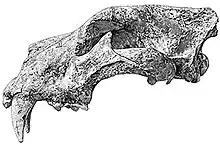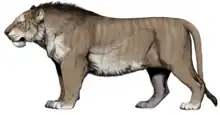| Panthera fossilis Temporal range: | |
|---|---|
 | |
| Skull from Azé, France | |
 | |
| Life restoration | |
| Scientific classification | |
| Domain: | Eukaryota |
| Kingdom: | Animalia |
| Phylum: | Chordata |
| Class: | Mammalia |
| Order: | Carnivora |
| Suborder: | Feliformia |
| Family: | Felidae |
| Subfamily: | Pantherinae |
| Genus: | Panthera |
| Species: | †P. fossilis |
| Binomial name | |
| †Panthera fossilis (Reichenau, 1906) | |
| Synonyms | |
| |
Panthera fossilis (also known as Panthera leo fossilis or Panthera spelaea fossilis), is an extinct species of cat belonging to the genus Panthera, known from remains found in Eurasia spanning the Middle Pleistocene and possibly into the Early Pleistocene. P. fossilis has sometimes been referred to by the common names steppe lion or cave lion,[1] though these names are conventionally restricted to the later related species P. spelaea,[2] to which P. fossilis is probably ancestral.[3]
Discoveries
It was first described from remains excavated near Mauer in Germany.[4] Bone fragments of P. fossilis were also excavated near Pakefield in the United Kingdom, which are estimated at 680,000 years old.[5] Bone fragments excavated near Isernia in Italy are estimated at between 600,000 and 620,000 years old.[6] The first Asian record of a fossilis lion was found in the Kuznetsk Basin in western Siberia and dates to the late Early Pleistocene.[7]
Evolution
P. fossilis is estimated to have evolved in Eurasia about 600,000 years ago from a large pantherine cat that originated in the Tanzanian Olduvai Gorge about 1.2–1.7 million years ago. This cat entered Eurasia about 780,000–700,000 years ago and gave rise to several lion-like forms. The first fossils that can be definitively classified as P. fossilis date to 610,000 years ago. Recent nuclear genomic evidence suggest that interbreeding between modern lions and all Eurasian fossil lions took place up until 500,000 years ago, but by 470,000 years ago, no subsequent interbreeding between the two lineages occurred.[8][7]
Characteristics
Bone fragments of P. fossilis indicate that it was larger than the modern lion and was among the largest cats. Skeletal remains of P. fossilis populations in Siberia measure larger than those in Central Europe.[7][9] Compared to a modern lion, P. fossilis had a slightly wider skull and nasal cavity, smaller orbits, less inflated bullae, less specialized lower teeth, reduced lower premolars and smaller incisors.[10]
Taxonomic history
P. fossilis was historically considered an early lion (P. leo) subspecies as Panthera leo fossilis.[6] Some authors considered it a subspecies of Panthera spelaea (Panthera spelaea fossilis) or treat it as a distinct species.[11][12] Some employ a subgenus of Panthera, "Leo", to contain several lion-like members of Panthera, including P. leo, P. spelaea, P. atrox and P. fossilis.[7] A 2022 study concluded that P. fossilis and P. spelaea represented a chronospecies lineage, with most differences between the two species explainable by size differences.[3]
Results of mitochondrial genome sequences derived from two Beringian specimens of Panthera spelaea indicate that it and Panthera fossilis were distinct enough from the modern lion to be considered separate species.[13]
Palaeobiology
This lion coexisted with early humans and prehistoric fauna.[14] A mandible from the early hominid Homo heidelbergensis was excavated in 1907 at Mauer, Germany.[15]
Herbivores that coexisted with the lion included the hippopotamus, narrow-nosed rhinoceros, straight-tusked elephant, southern mammoth, moose, steppe bison and fallow deer. Sympatric predators included bears, wolves, hyenas and saber-toothed cats.[14][7][9]
See also
References
- ↑ Hallett, Mark; Harris, John (2020), Appendix 4. Species of the Genus Panthera, Columbia University Press, pp. 211–216, doi:10.7312/hall18450-014, ISBN 978-0-231-54552-5, S2CID 243319924
- ↑ Diedrich, C. G. (2014). "Palaeopopulations of Late Pleistocene Top Predators in Europe: Ice Age Spotted Hyenas and Steppe Lions in Battle and Competition about Prey". Paleontology Journal. 2014: 1–34. doi:10.1155/2014/106203.
- 1 2 Sabo, Martin; Tomašových, Adam; Gullár, Juraj (August 2022). "Geographic and temporal variability in Pleistocene lion-like felids: Implications for their evolution and taxonomy". Palaeontologia Electronica. 25 (2): 1–27. doi:10.26879/1175. ISSN 1094-8074. S2CID 251855356.
- ↑ Reichenau, W. V. (1906). "Beiträge zur näheren Kenntnis der Carnivoren aus den Sanden von Mauer und Mosbach". Abhandlungen der Großherzoglichen Hessischen Geologischen Landesanstalt zu Darmstadt. 4 (2): 125.
- ↑ Lewis, M.; Pacher, M.; Turner, A. (2010). "The larger Carnivora of the West Runton Freshwater Bed". Quaternary International. 228 (1–2): 116–135. Bibcode:2010QuInt.228..116L. doi:10.1016/j.quaint.2010.06.022.
- 1 2 Sala, B. (1990). "Panthera leo fossilis (v. Reichenau, 1906) (Felidae) de Iserna la Pineta (Pléistocene moyen inférieur d'Italie)". Géobios. 23 (2): 189–194. doi:10.1016/S0016-6995(06)80051-3.
- 1 2 3 4 5 Sotnikova, M.V. & Foronova, I.V. (2014). "First Asian record of Panthera (Leo) fossilis (Mammalia, Carnivora, Felidae) in the Early Pleistocene of Western Siberia, Russia". Integrative Zoology. 9 (4): 517–530. doi:10.1111/1749-4877.12082. PMID 24382145.
- ↑ Manuel, M. d.; Ross, B.; Sandoval-Velasco, M.; Yamaguchi, N.; Vieira, F. G.; Mendoza, M. L. Z.; Liu, S.; Martin, M. D.; Sinding, M.-H. S.; Mak, S. S. T.; Carøe, C.; Liu, S.; Guo, C.; Zheng, J.; Zazula, G.; Baryshnikov, G.; Eizirik, E.; Koepfli, K.-P.; Johnson, W. E.; Antunes, A.; Sicheritz-Ponten, T.; Gopalakrishnan, S.; Larson, G.; Yang, H.; O’Brien, S. J.; Hansen, A. J.; Zhang, G.; Marques-Bonet, T.; Gilbert, M. T. P. (2020). "The evolutionary history of extinct and living lions". PNAS. 117 (20): 10927–10934. Bibcode:2020PNAS..11710927D. doi:10.1073/pnas.1919423117. PMC 7245068. PMID 32366643.
- 1 2 Burger, J.; Rosendahl, W.; Loreille, O.; Hemmer, H.; Eriksson, T.; Götherström, A.; Hiller, J.; Collins, M. J.; Wess, T. & Alt, K. W. (2004). "Molecular phylogeny of the extinct cave lion Panthera leo spelaea". Molecular Phylogenetics and Evolution. 30 (3): 841–849. doi:10.1016/j.ympev.2003.07.020. PMID 15012963.
- ↑ Sabol, M. (2014). "Panthera fossilis (Reichenau, 1906) (Felidae, Carnivora) from Za Hájovnou Cave (Moravia, The Czech Republic): A Fossil Record from 1987-2007". Acta Musei Nationalis Pragae, Series B, Historia Naturalis. 70 (1–2): 59–70. doi:10.14446/AMNP.2014.59.
- ↑ Marciszak, A.; Stefaniak, K. (2010). "Two forms of cave lion: Middle Pleistocene Panthera spelaea fossilis Reichenau, 1906 and Upper Pleistocene Panthera spelaea spelaea Goldfuss, 1810 from the Bísnik Cave, Poland". Neues Jahrbuch für Geologie und Paläontologie - Abhandlungen. 258 (3): 339–351. doi:10.1127/0077-7749/2010/0117.
- ↑ Marciszak, A.; Schouwenburg, C.; Darga, R. (2014). "Decreasing size process in the cave (Pleistocene) lion Panthera spelaea (Goldfuss, 1810) evolution – A review". Quaternary International. Fossil remains in karst and their role in reconstructing Quaternary paleoclimate and paleoenvironments. 339–340: 245–257. Bibcode:2014QuInt.339..245M. doi:10.1016/j.quaint.2013.10.008.
- ↑ Barnett, R.; Mendoza, M. L. Z.; Soares, A. E. R.; Ho, S. Y. W.; Zazula, G.; Yamaguchi, N.; Shapiro, B.; Kirillova, I. V.; Larson, G.; Gilbert, M. T. P. (2016). "Mitogenomics of the extinct Cave Lion, Panthera spelaea (Goldfuss, 1810), resolve its position within the Panthera cats". Open Quaternary. 2: 4. doi:10.5334/oq.24. hdl:10576/22920.
- 1 2 Jackson, D. (2010). "Introduction". Lion. London: Reaktion Books. pp. 1–21. ISBN 978-1861897350.
- ↑ Schoetensack, O. (1908). Der Unterkiefer des Homo heidelbergensis aus den Sanden von Mauer bei Heidelberg. Ein Beitrag zur Paläontologie des Menschen. Leipzig: Engelmann.